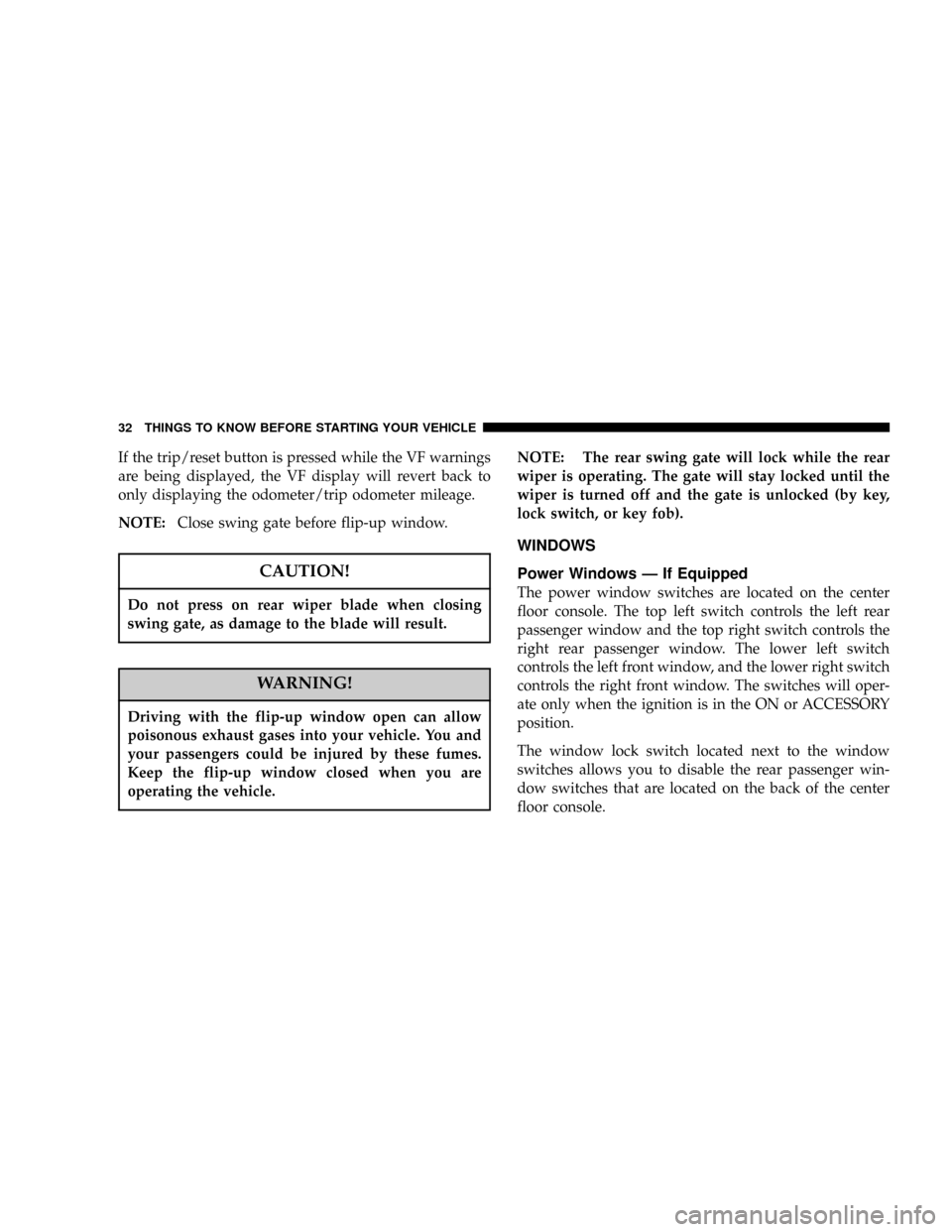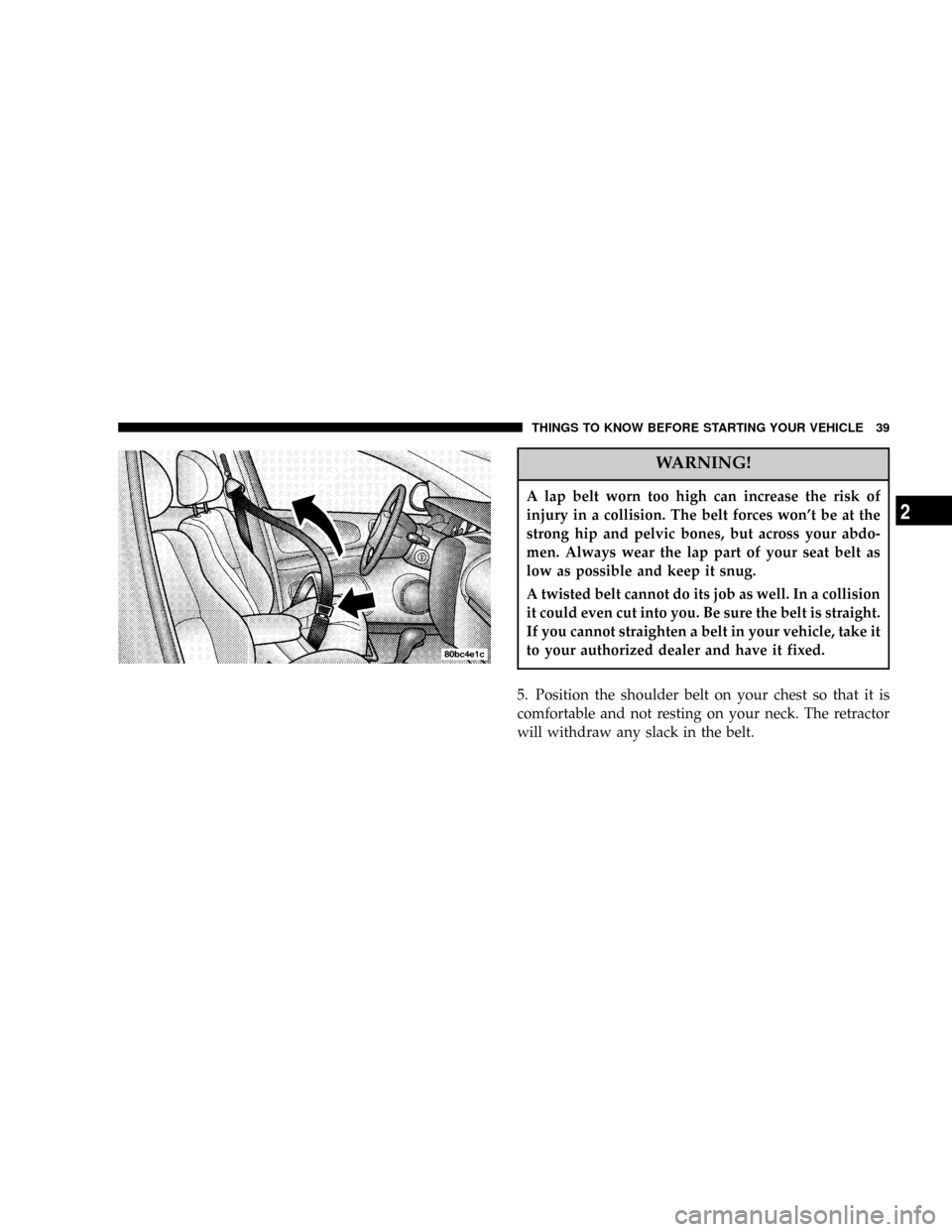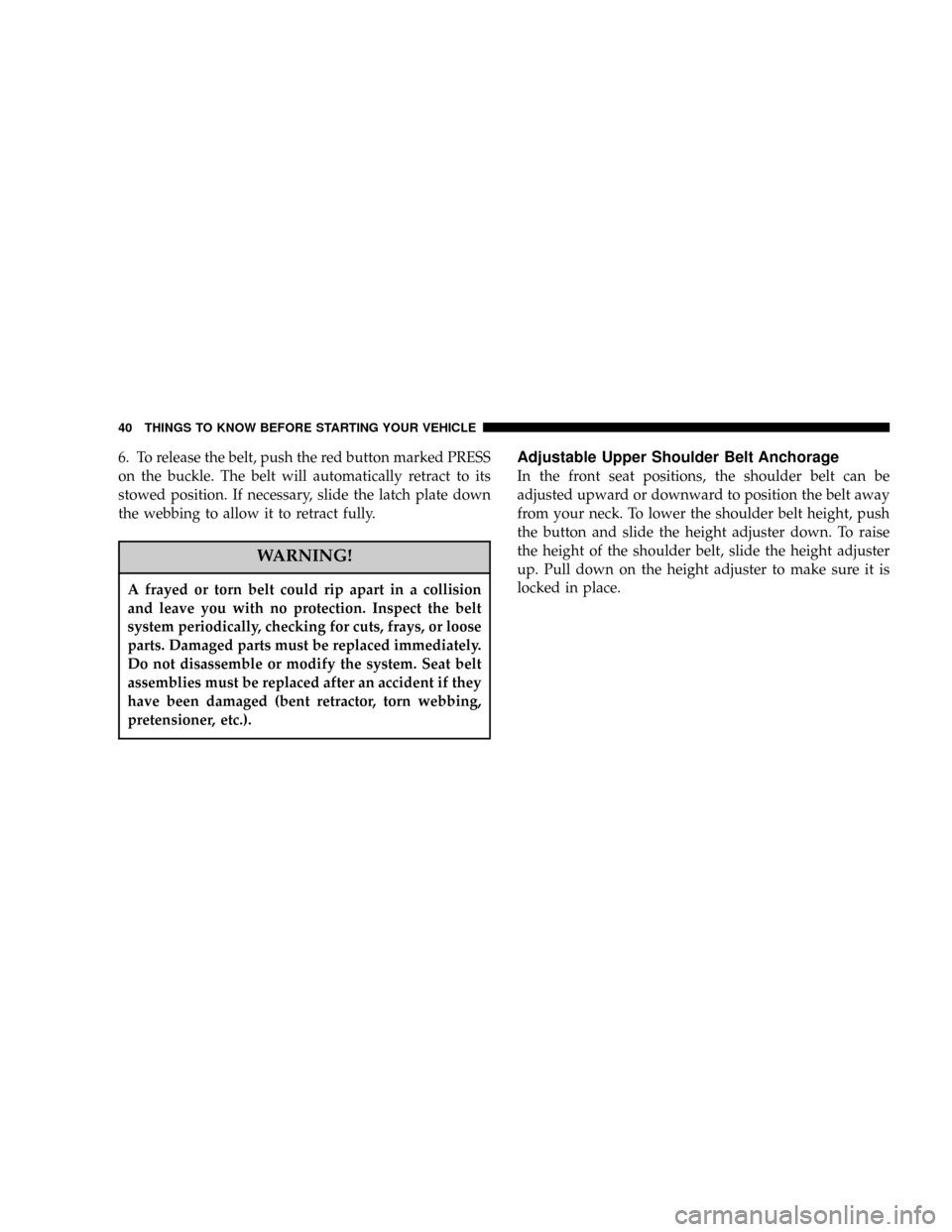JEEP LIBERTY 2004 KJ / 1.G Owner's Guide
Manufacturer: JEEP, Model Year: 2004, Model line: LIBERTY, Model: JEEP LIBERTY 2004 KJ / 1.GPages: 374, PDF Size: 5.71 MB
Page 31 of 374

NOTE:If vehicle is equipped with the optional Elec-
tronic Vehicle Information Center (EVIC) in the overhead
console, all warnings including ªdoorº, ªGATEº,
ªGLASSº, and ªLOWASHº will only be displayed in the
EVIC display (not in the instrument cluster). For addi-
tional information, refer to ªOverhead Console Ð If
Equippedº in Section 3.
If any other active warnings including ªdoorº or ªLO-
WASHº are present, they will be shown in the VF display
and will also continue to cycle. If the vehicle is moving,
two single chimes will occur if the rear glass is open or
three single chimes will occur if the rear swing gate is
open (one chime for each complete display cycle). After
this, the VF display will continue to sequence only (no
chimes).
THINGS TO KNOW BEFORE STARTING YOUR VEHICLE 31
2
Page 32 of 374

If the trip/reset button is pressed while the VF warnings
are being displayed, the VF display will revert back to
only displaying the odometer/trip odometer mileage.
NOTE:Close swing gate before flip-up window.
CAUTION!
Do not press on rear wiper blade when closing
swing gate, as damage to the blade will result.
WARNING!
Driving with the flip-up window open can allow
poisonous exhaust gases into your vehicle. You and
your passengers could be injured by these fumes.
Keep the flip-up window closed when you are
operating the vehicle.
NOTE: The rear swing gate will lock while the rear
wiper is operating. The gate will stay locked until the
wiper is turned off and the gate is unlocked (by key,
lock switch, or key fob).
WINDOWS
Power Windows Ð If Equipped
The power window switches are located on the center
floor console. The top left switch controls the left rear
passenger window and the top right switch controls the
right rear passenger window. The lower left switch
controls the left front window, and the lower right switch
controls the right front window. The switches will oper-
ate only when the ignition is in the ON or ACCESSORY
position.
The window lock switch located next to the window
switches allows you to disable the rear passenger win-
dow switches that are located on the back of the center
floor console.
32 THINGS TO KNOW BEFORE STARTING YOUR VEHICLE
Page 33 of 374

Auto Down Feature Ð If Equipped
The driver's and passenger's front window switches
have an auto down feature. Press the window switch past
the detent, release, and the window will go down auto-
matically.To open the window part way, press the window switch
part way and release it when you want the window to
stop.
Rear Passenger Window Switches
The rear passenger window switches are located on the
back of the center floor console.
THINGS TO KNOW BEFORE STARTING YOUR VEHICLE 33
2
Page 34 of 374

Wind Buffeting
Wind buffeting can be described as the perception of
pressure on the ears or a helicopter type sound in the
ears. Your vehicle may exhibit wind buffeting with the
windows down, or the sunroof (if equipped) in certain
open or partially open positions. This is a normal occur-
rence and can be minimized. If the buffeting occurs with
the sunroof open, adjust the sunroof opening to minimize
the buffeting.
OCCUPANT RESTRAINTS
Some of the most important safety features in your
vehicle are the restraint systems. These include the front
and rear seat belts for the driver and all passengers, front
airbags for both the driver and front passenger and, if
equipped, window bags for the driver and passengers
seated next to a window. If you will be carrying children
too small for adult-size belts, your seat belts also can be
used to hold infant and child restraint systems.NOTE:The front airbags have a multi stage inflator
design. This allows the airbag to have different rates of
inflation that are based on collision severity.
Please pay close attention to the information in this
section. It tells you how to use your restraint system
properly to keep you and your passengers as safe as
possible.
WARNING!
In a collision, you and your passengers can suffer
much greater injuries if you are not properly buck-
led up. You can strike the interior of your vehicle or
other passengers, or you can be thrown out of the
vehicle. Always be sure you and others in your
vehicle are buckled up properly.
34 THINGS TO KNOW BEFORE STARTING YOUR VEHICLE
Page 35 of 374

Buckle up even though you are an excellent driver, even
on short trips. Someone on the road may be a poor driver
and cause a collision which includes you. This can
happen far away from home or on your own street.
Research has shown that seat belts save lives, and they
can reduce the seriousness of injuries in a collision. Some
of the worst injuries happen when people are thrown
from the vehicle. Seat belts reduce the possibility of
ejection and the risk of injury caused by striking the
inside of the vehicle.Everyonein a motor vehicle should
be belted at all times.Lap/Shoulder Belts
All the seats in your vehicle are equipped with lap/
shoulder belts.
The belt webbing retractor is designed to lock during
very sudden stops or collisions. This feature allows the
shoulder part of the belt to move freely with you under
normal conditions. But in a collision, the belt will lock
and reduce the risk of you striking the inside of the
vehicle or being thrown out.
THINGS TO KNOW BEFORE STARTING YOUR VEHICLE 35
2
Page 36 of 374

WARNING!
²Wearing a seat belt incorrectly is dangerous. Seat
belts are designed to go around the large bones of
your body. These are the strongest parts of your
body and can take the forces of a collision the
best. Wearing your belt in the wrong place could
make your injuries in a collision much worse. You
might suffer internal injuries, or you could even
slide out of part of the belt. Follow these instruc-
tions to wear your seat belt safely and to keep
your passengers safe, too.
²Two people should never be belted into a single
seat belt. People belted together can crash into one
another in an accident, hurting one another badly.
Never use a lap/shoulder belt or a lap belt for
more than one person, no matter what their size.
Lap/Shoulder Belt Operating Instructions
1. Enter the vehicle and close the door. Sit back and
adjust the seat.
2. The seat belt latch plate is above the back of your seat.
Grasp the latch plate and pull out the belt. Slide the latch
plate up the webbing as far as necessary to make the belt
go around your lap.
36 THINGS TO KNOW BEFORE STARTING YOUR VEHICLE
Page 37 of 374

3. When the belt is long enough to fit, insert the latch
plate into the buckle until you hear a ªclick.º
THINGS TO KNOW BEFORE STARTING YOUR VEHICLE 37
2
Page 38 of 374

WARNING!
A belt that is buckled into the wrong buckle will not
protect you properly. The lap portion could ride too
high on your body, possibly causing internal injuries.
Always buckle your belt into the buckle nearest you.
A belt that is too loose will not protect you as well. In a
sudden stop you could move too far forward, increasing
the possibility of injury. Wear your seat belt snugly.
A belt that is worn under your arm is very dangerous.
Your body could strike the inside surfaces of the vehicle
in a collision, increasing head and neck injury. A belt
worn under the arm can cause internal injuries. Ribs
aren't as strong as shoulder bones. Wear the belt over
your shoulder so that your strongest bones will take the
force in a collision.
A shoulder belt placed behind will not protect you from
injury during a collision. You are more likely to hit your
head in a collision if you do not wear your shoulder
belt. The lap and shoulder belt are meant to be used
together.
4. Position the lap belt across your thighs, below your
abdomen. To remove slack in the lap portion, pull up a
bit on the shoulder belt. To loosen the lap belt if it is too
tight, tilt the latch plate and pull on the lap belt. A snug
belt reduces the risk of sliding under the belt in a
collision.
NOTE:The ªSeat Belt Indicator Lightº will remain on
until the driver's seat belt is buckled.
38 THINGS TO KNOW BEFORE STARTING YOUR VEHICLE
Page 39 of 374

WARNING!
A lap belt worn too high can increase the risk of
injury in a collision. The belt forces won't be at the
strong hip and pelvic bones, but across your abdo-
men. Always wear the lap part of your seat belt as
low as possible and keep it snug.
A twisted belt cannot do its job as well. In a collision
it could even cut into you. Be sure the belt is straight.
If you cannot straighten a belt in your vehicle, take it
to your authorized dealer and have it fixed.
5. Position the shoulder belt on your chest so that it is
comfortable and not resting on your neck. The retractor
will withdraw any slack in the belt.
THINGS TO KNOW BEFORE STARTING YOUR VEHICLE 39
2
Page 40 of 374

6. To release the belt, push the red button marked PRESS
on the buckle. The belt will automatically retract to its
stowed position. If necessary, slide the latch plate down
the webbing to allow it to retract fully.
WARNING!
A frayed or torn belt could rip apart in a collision
and leave you with no protection. Inspect the belt
system periodically, checking for cuts, frays, or loose
parts. Damaged parts must be replaced immediately.
Do not disassemble or modify the system. Seat belt
assemblies must be replaced after an accident if they
have been damaged (bent retractor, torn webbing,
pretensioner, etc.).
Adjustable Upper Shoulder Belt Anchorage
In the front seat positions, the shoulder belt can be
adjusted upward or downward to position the belt away
from your neck. To lower the shoulder belt height, push
the button and slide the height adjuster down. To raise
the height of the shoulder belt, slide the height adjuster
up. Pull down on the height adjuster to make sure it is
locked in place.
40 THINGS TO KNOW BEFORE STARTING YOUR VEHICLE